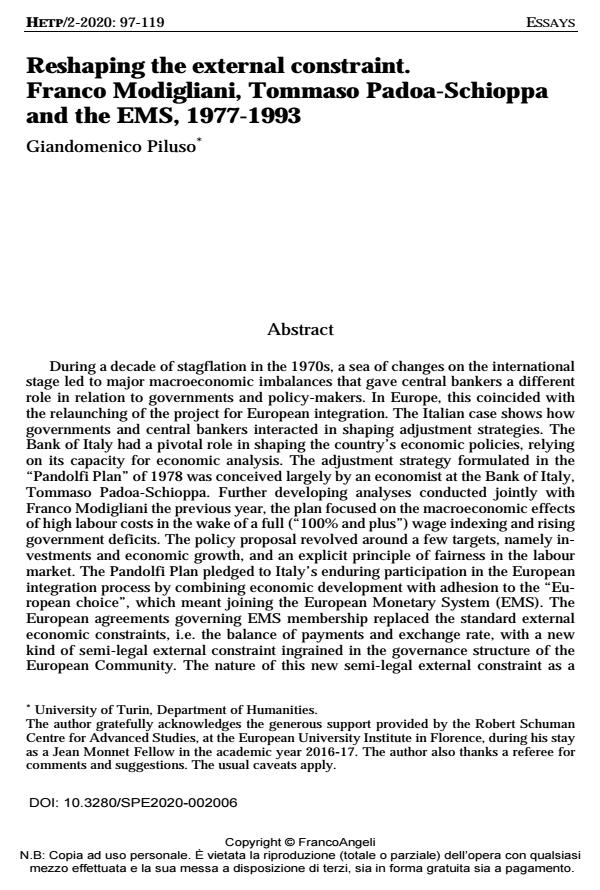Reshaping the external constraint. Franco Modigliani, Tommaso Padoa-Schioppa and the EMS, 1977-1993
Journal title HISTORY OF ECONOMIC THOUGHT AND POLICY
Author/s Giandomenico Piluso
Publishing Year 2021 Issue 2020/2
Language English Pages 23 P. 97-119 File size 128 KB
DOI 10.3280/SPE2020-002006
DOI is like a bar code for intellectual property: to have more infomation
click here
Below, you can see the article first page
If you want to buy this article in PDF format, you can do it, following the instructions to buy download credits

FrancoAngeli is member of Publishers International Linking Association, Inc (PILA), a not-for-profit association which run the CrossRef service enabling links to and from online scholarly content.
During a decade of stagflation in the 1970s, a sea of changes on the interna-tional stage led to major macroeconomic imbalances that gave central bankers a different role in relation to governments and policy-makers. In Europe, this coin-cided with the relaunching of the project for European integration. The Italian case shows how governments and central bankers interacted in shaping adjustment strategies. The Bank of Italy had a pivotal role in shaping the country’s economic policies, relying on its capacity for economic analysis. The adjustment strategy formulated in the "Pandolfi Plan" of 1978 was conceived largely by an economist at the Bank of Italy, Tommaso Padoa-Schioppa. Further developing analyses conducted jointly with Franco Modigliani the previous year, the plan focused on the macroeconomic effects of high labour costs in the wake of a full ("100% and plus") wage indexing and rising government deficits. The policy proposal revolved around a few targets, namely investments and economic growth, and an explicit principle of fairness in the labour market. The Pandolfi Plan pledged to Italy’s en-during participation in the European integration process by combining economic development with adhesion to the "European choice", which meant joining the European Monetary System (EMS). The European agreements governing EMS membership replaced the standard external economic constraints, i.e. the balance of payments and exchange rate, with a new kind of semi-legal external constraint ingrained in the governance structure of the European Community. The nature of this new semi-legal external constraint as a fiscal discipline mechanism eventually emerged more clearly with the Maastricht Treaty.
Keywords: European Monetary System-EMS, Franco Modigliani, Tommaso Padoa-Schioppa, external constraints, Keynesian economics, Ordoliberalism, optimal currency area
Jel codes: A11, B31, E42, E58, F15, F33, H12, H6, J08
Giandomenico Piluso, Reshaping the external constraint. Franco Modigliani, Tommaso Padoa-Schioppa and the EMS, 1977-1993 in "HISTORY OF ECONOMIC THOUGHT AND POLICY" 2/2020, pp 97-119, DOI: 10.3280/SPE2020-002006